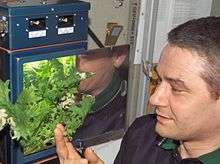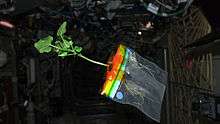Space farming

Space farming refers to the cultivation of crops for food and other materials in space or on off-Earth celestial objects – equivalent to agriculture on Earth.
Farming on the Moon or Mars share many similarities with farming on a space station or space colony, but would lack the complexity of microgravity found in the latter. Each environment would also have differences in the availability of inputs to the space agriculture process: inorganic material needed for plant growth, soil media, insolation, relative availability of carbon dioxide, nitrogen and oxygen, and so forth.
Introduction

Supply of food to space stations and proposed interplanetary spaceships is staggeringly expensive. Furthermore, the impracticality of resupplying interplanetary missions make the prospect of growing food inflight appealing. The existence of a space farm would aid the creation of a sustainable environment, as plants can be used to recycle wastewater, generate oxygen (10m² of crops produces 25% of the daily requirements of 1 person, or about 180-210grams of oxygen[1]), continuously purify the air and recycle faeces on the space station or spaceship. This essentially allows the space farm to turn the spaceship into an artificial ecosystem with a hydrological cycle and nutrient recycling.
Supply of foodstuffs to others is likely to be a major part of early off-Earth settlements. Food production is a non-trivial task and is likely to be one of the most labor-intensive, and vital, tasks of early colonists. Among others, NASA is researching how to accomplish space farming.[2]
Technical challenges

A variety of technical challenges will face colonists who attempt to do off-Earth agriculture. These include:[2]
- the effect of reduced gravity on various greenhouse crops
- reduced lighting in some locations; for example, Mars receives about half of the solar radiation as Earth does, and any pressurized greenhouse enclosure will further reduce the light reaching plants. Moon locations or orbital colonies would likely receive more sunlight due to the absence of a humid atmosphere as on Earth and therefore would have more solar energy available to reach the plant.
- plant growth under conditions of lower pressure atmosphere, because the higher the pressure inside a greenhouse the more massive the structural elements and enclosure of the greenhouse must be. At one tenth of standard atmospheric pressure plants can still function.
- effects of dealing with the higher radiation without the protective effect of Earth's atmosphere and the Van Allen radiation belts will require shielding or mitigation
Experiments
- The "Greenhab" at the Mars desert research station in Utah contains a greenhouse which is designed to emulate some of the challenges resulting from farming on Mars.
- The Lada experiment and the European Modular Cultivation System[3] on the International Space Station is used to grow small amounts of fresh food.
- In 2013, NASA funded research to develop a 3D food printer.[4]
Crops experimented with
Following crops have been considered for use in space farms:[1] potatoes, grains, rice, beans, tomatoes, paprika, lettuce, cabbage, strawberry
See also
References
.jpg)
- 1 2 Kijk magazine 9/2015
- 1 2 Moskowitz, Clara (2013-05-15). "Farming on Mars? NASA ponders food supply for 2030 mission". Fox News. Retrieved 2014-05-18.
- ↑ "NASA - European Modular Cultivation System". web.archive.org. Retrieved 2014-04-22.
- ↑ "http://www.3ders.org/articles/20130521-nasa-grant-to-fund-3d-food-printer.html". 3ders News. 2013-05-21. Retrieved 2014-05-18. External link in
|title=(help)
- "HowStuffWorks "How Space Farming Works"". science.howstuffworks.com. Retrieved 2014-04-22.
- "Advanced Astroculture TM (ADVASC)" ISS Program Scientist's Office. 3/7/2008. (5/14/2008) http://www.nasa.gov/mission_pages/station/science/experiments/ADVASC.html
- "Analysis of a Novel Sensory Mechanism in Root Phototropism (Tropi)" ISS Program Scientist's Office. 12/21/2007. (5/14/2008) http://www.nasa.gov/mission_pages/station/science/experiments/Tropi.html
- "Biomass Production System (BPS)" ISS Program Scientist's Office. 2/8/2008. (5/14/2008) http://www.nasa.gov/mission_pages/station/science/experiments/BPS.html#backtoTop
- Encyclopædia Britannica. "International Space Station." 2008. (5/14/2008) http://www.britannica.com/EBchecked/topic/747712/International- Space-Station
- "European Modular Cultivation System." European Space Agency. (5/14/2008) http://www.spaceflight.esa.int/users/index.cfm?act=default.page& level=11&page=fac-iss-dest-emcs
- Franzen, Harald. "Space Farming Presents Challenges." Scientific American. 4/11/2001. (5/12/2008) http://www.sciam.com/article.cfm?id=space-farming-presents-ch
- Halvorson, Todd. "Lettuce and LEDs: Shedding New Light On Space Farming." Space.com. 9/26/2001. (5/13/2008) http://www.space.com/businesstechnology/technology/light_farming_ 010926.html
- Katayami, N. et al. "Entomophagy; a key to space agriculture." Space Agriculture Task Force. (5/13/2008) http://webcache.googleusercontent.com/search?q=cache:SW8_KSs1zZ0J:surc.isas. ac.jp/space_agriculture/Archive/PDF/Insect_Eating_ASR2006-g. pdf+eating+insects+space+farming&hl=en&ct=clnk&cd=3&gl=us&client =Firefox-a
- Mansfield, Cheryl. "Orbiting Agriculture." John F. Kennedy Space Center. 10/20/2005. (5/14/2008) http://www.nasa.gov/missions/science/f_lada.html
- "Molecular and Plant Physiological Analyses of the Microgravity Effects on Multigeneration Studies of Arabidopsis thaliana (Multigen)" ISS Program Scientist's Office. 3/21/2008. (5/14/2008) http://www.nasa.gov/mission_pages/station/science/experiments/ Multigen.html
- "Photosynthesis Experiment and System Testing Operation (PESTO)." ISS Program Scientist's Office. 3/14/2008. (5/14/2008) http://www.nasa.gov/mission_pages/station/science/experiments/PESTO.html#top
- "Plant Generic Bioprocessing Apparatus (PGBA)." ISS Program Scientist's Office. 12/7/2007. (5/14/2008) http://www.nasa.gov/mission_pages/station/science/experiments/ PGBA.html
- Quinn, Sheri. "Plants as Important in Space as on Earth." Voice of America 4/8/2008. (5/13/2008) http://www.globalsecurity.org/space/library/news/2008/space-080408- voa02.htm
- The Kitchen Sisters. "Beyond Tang: Food in Space." NPR. 6/7/2007. (5/12/2008) http://www.npr.org/templates/story/story.php?storyId=10792763
- "The Optimization of Root Zone Substrates (ORZS) for Reduced Gravity Experiments Program." ISS Program Scientist's Office. 3/28/2008. (5/14/2008) http://www.nasa.gov/mission_pages/station/science/experiments/ ORZS.html
- "Threshold Acceleration for Gravisensing (Gravi)." ISS Program Scientist's Office. 1/11/2008. (5/14/2008) http://www.nasa.gov/mission_pages/station/science/experiments/ Gravi.html
External links
- International Space Station: A First For Space Farming
- Greenhouses for Mars
- Sunlight on Mars: Is there enough light on mars to grow tomatoes?
- Award-winning Mars garden
- Plant biology at low atmospheric pressures in support of Earth-orbital, lunar, or Martian plant growth facilities
